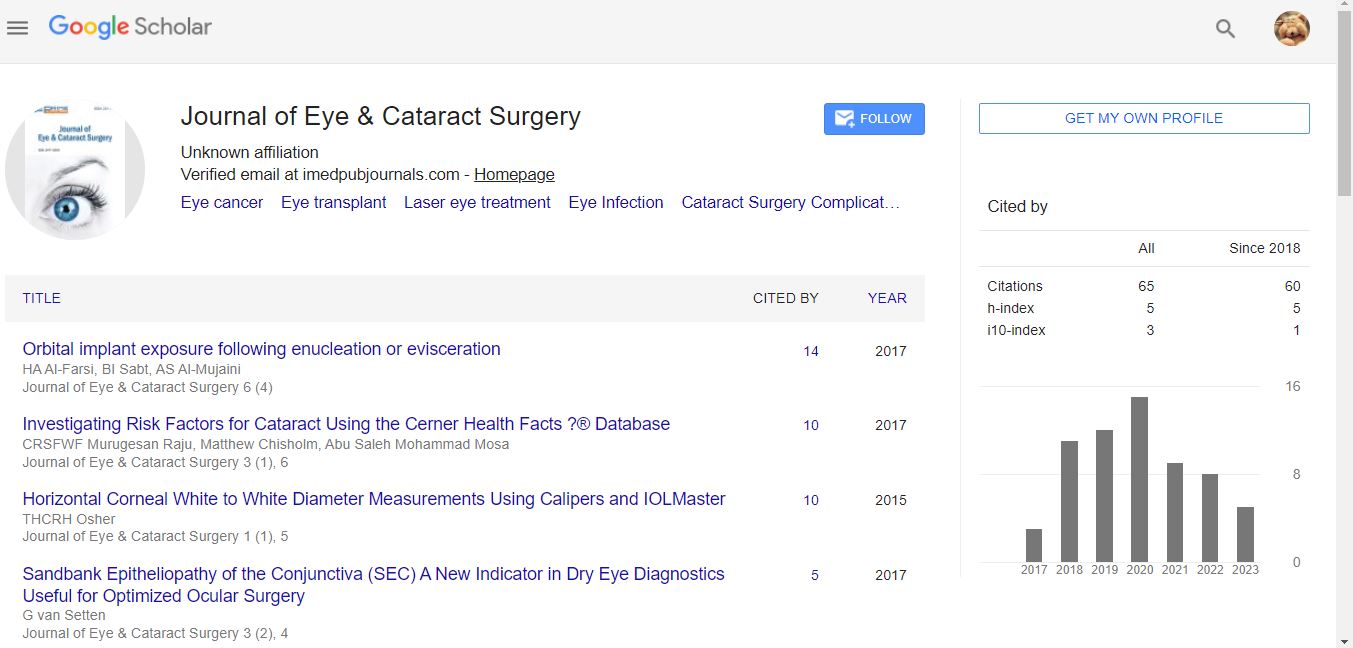Commentary - (2023) Volume 9, Issue 2
Enhancing Your Vision: Exploring the World of Contact Lenses
Yang Lyu*
Department of Optics, University of Granada, Spain
*Correspondence:
Yang Lyu,
Department of Optics, University of Granada,
Spain,
Email:
Received: 31-May-2023, Manuscript No. IPJECS-23-17654;
Editor assigned: 02-Jun-2023, Pre QC No. IPJECS-23-17654;
Reviewed: 16-Jun-2023, QC No. IPJECS-23-17654;
Revised: 21-Jun-2023, Manuscript No. IPJECS-23-17654;
Published:
28-Jun-2023, DOI: 10.21767/2471-8300.9.2.17
Description
Implantable contact lenses, also known as implantable collamer
lenses or phakic intraocular lenses, are precisely crafted,
biocompatible lenses that are surgically inserted into the eye to
correct refractive errors such as myopia near sightedness, hyperopia
farsightedness, and astigmatism. Unlike traditional contact
lenses that rest on the surface of the eye, these lenses are
placed inside the eye, typically in front of the natural lens and
behind the iris, making them nearly invisible to the naked eye.
Sharper Vision implantable contact lenses can offer sharper and
clearer vision compared to eyeglasses or regular contact lenses.
This is due to their proximity to the eye’s natural lens, allowing
for more direct and accurate focusing of light onto the retina.
Permanent correction unlike glasses or traditional contact lenses
that need to be worn and removed daily, implantable contact
lenses provide a more long-term solution. Once inserted, they
can stay in the eye for an extended period or even permanently,
reducing the need for constant maintenance and cleaning.
Wide range of vision these lenses can provide a wider field of
vision compared to other corrective measures. They can also be
used to correct high degrees of refractive errors that might not
be suitable for other vision correction methods. Reduced visual
distortions many wearers of implantable contact lenses report
experiencing fewer visual distortions, such as glare and halos,
especially during night driving. This can lead to enhanced overall
visual comfort. Suitable for active lifestyles Individuals who enjoy
sports, outdoor activities, or have professions that demand
clear vision without the hindrance of glasses or frequent contact
lens adjustments can benefit from the convenience of implantable
contact lenses. The insertion of implantable contact lenses
is a delicate surgical procedure that requires a skilled ophthalmologist.
It involves creating a small incision in the cornea to
insert the folded lens, which then unfolds and positions itself behind
the iris. The procedure is typically quick, minimally invasive,
and often done on an outpatient basis. Patients may experience
mild discomfort and temporary changes in vision during the
initial recovery period. While implantable contact lenses offer
significant advantages, there are certain considerations to keep
in mind. Irreversibility: The procedure is usually considered permanent,
so potential candidates should thoroughly discuss their
decision with their eye care professional. Risk of complications
as with any surgical procedure, there are risks involved, such as
infection, inflammation, or changes in intraocular pressure. Regular
follow-up appointments are essential to monitor the health
of the eyes post-surgery. Candidate selection not everyone is a
suitable candidate for implantable contact lenses. Factors such
as age, ocular health, and the degree of refractive error play a
role in determining eligibility. Cost the cost of the procedure
may vary based on geographic location and the specifics of the
individual case. It’s important to consider this factor alongside
potential long-term savings from reduced dependence on glasses
or regular contact lenses. Implantable contact lenses represent
a significant advancement in the field of vision correction.
As technology continues to evolve, we may see further refinements
in the design of these lenses, potentially expanding the
range of refractive errors they can correct and minimizing any
associated risks.
Acknowledgement
None.
Conflict Of Interest
None.
Citation: Lyu Y (2023) Enhancing Your Vision: Exploring the World of Contact Lenses. J Eye Cataract Surg. 9:17.
Copyright: © 2023 Lyu Y. This is an open-access article distributed under the terms of the Creative Commons Attribution License,
which permits unrestricted use, distribution, and reproduction in any medium, provided the original author and source are
credited.

